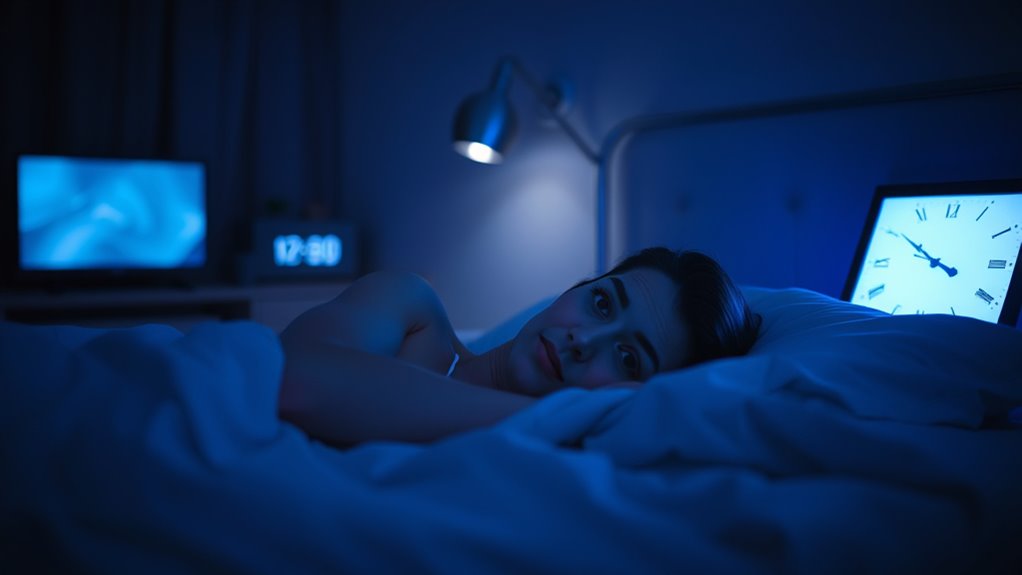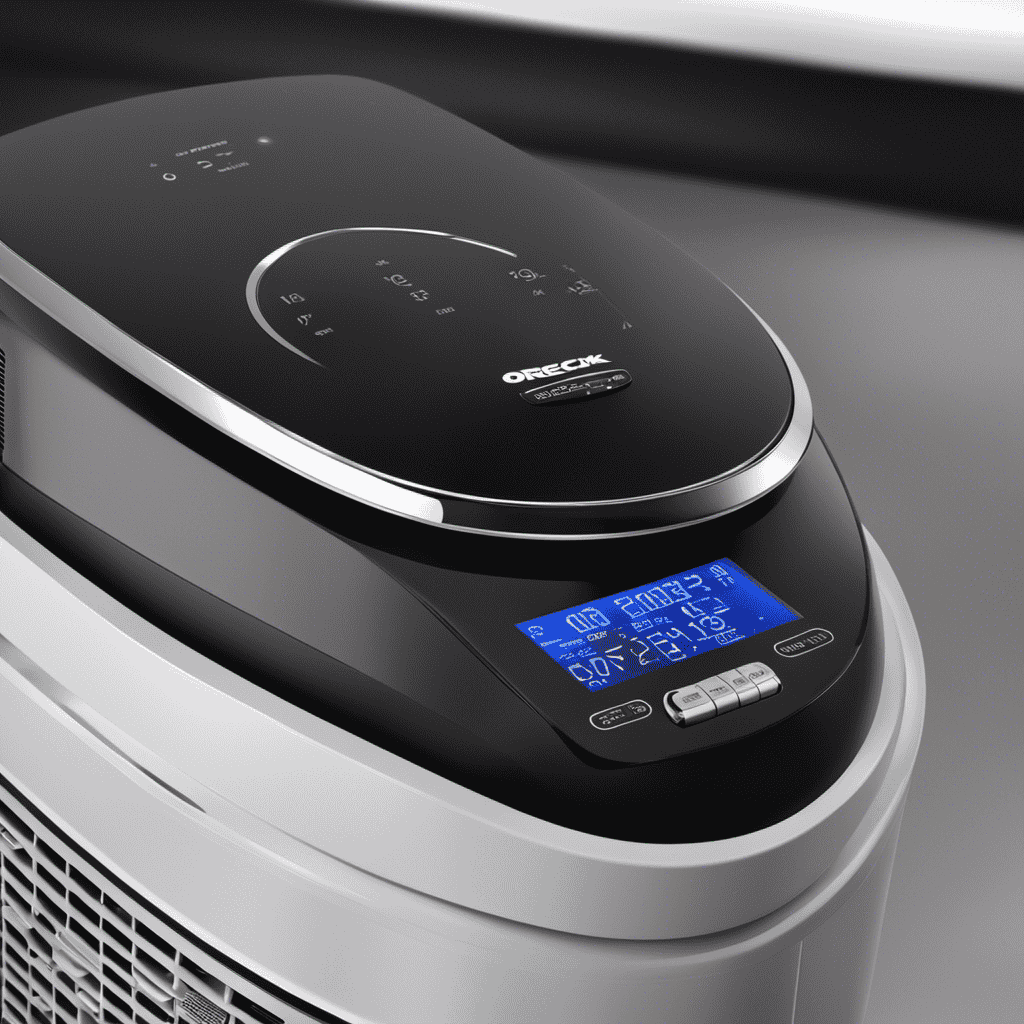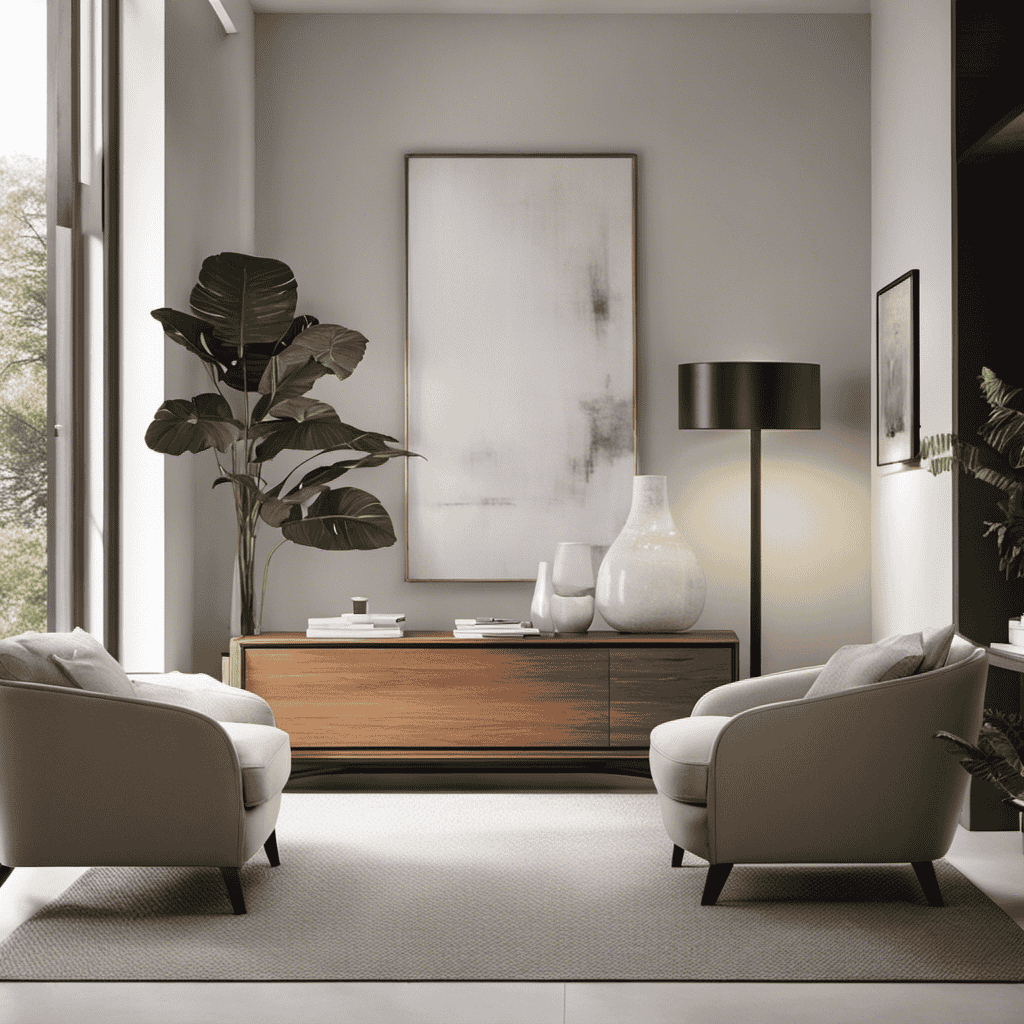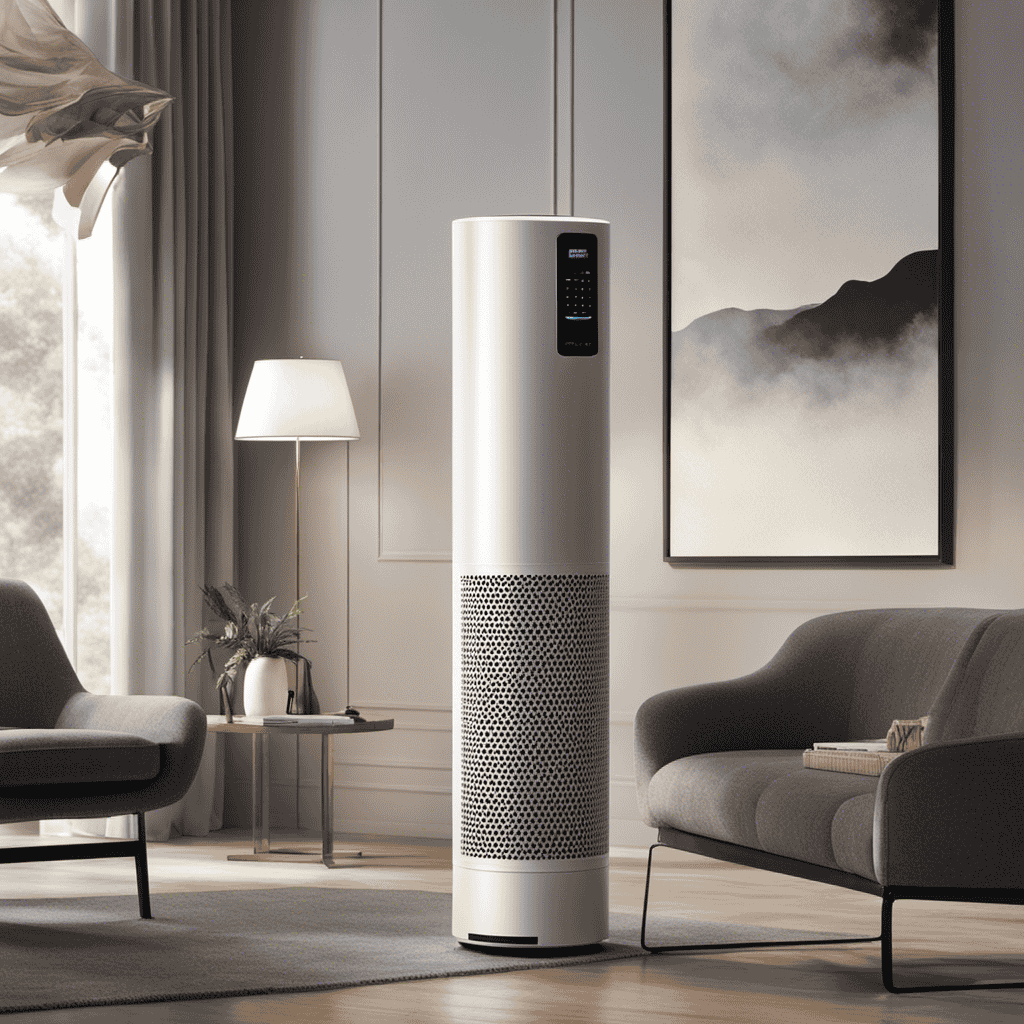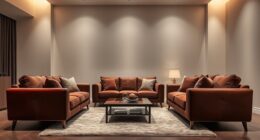What no one tells you about blue light and sleep is how silently it messes with your body’s internal clock. Blue light from screens suppresses melatonin, making it harder to fall asleep and stay asleep. It also disrupts your circadian rhythms, increasing sleep latency and fragmenting your rest. Long-term exposure can even affect your mood, alertness, and overall health. Stay tuned to uncover simple ways to protect your sleep and health from blue light’s hidden impact.
Key Takeaways
- Blue light suppresses melatonin production, delaying sleep onset and disrupting your natural circadian rhythm.
- Excessive evening blue light exposure can cause long-term health issues like metabolic problems and weakened immunity.
- It not only affects sleep quality but also accelerates eye damage and skin aging over time.
- The timing of blue light exposure influences brain alertness in the day but harms sleep if used late at night.
- Using filters, glasses, or apps to reduce blue light can significantly improve sleep quality and protect health.
How Blue Light Disrupts Your Natural Sleep Cycle

Blue light, which is emitted by screens on smartphones, tablets, and computers, can considerably disrupt your natural sleep cycle. This disruption is partly due to light pollution, especially when screens are used late at night. High screen brightness intensifies this effect, making it harder for your body to recognize when it’s time to wind down. The excess blue light signals your brain that it’s still daytime, delaying the production of melatonin—the hormone responsible for sleep. As a result, you may find it difficult to fall asleep or experience fragmented sleep. Automation technologies can also influence sleep patterns indirectly by increasing exposure to screens through work and entertainment. Reducing screen brightness before bed and limiting exposure to blue light can help your body better maintain its natural rhythm. Protecting your sleep environment from light pollution is essential for restful, restorative sleep.
The Hidden Connection Between Blue Light and Melatonin Suppression
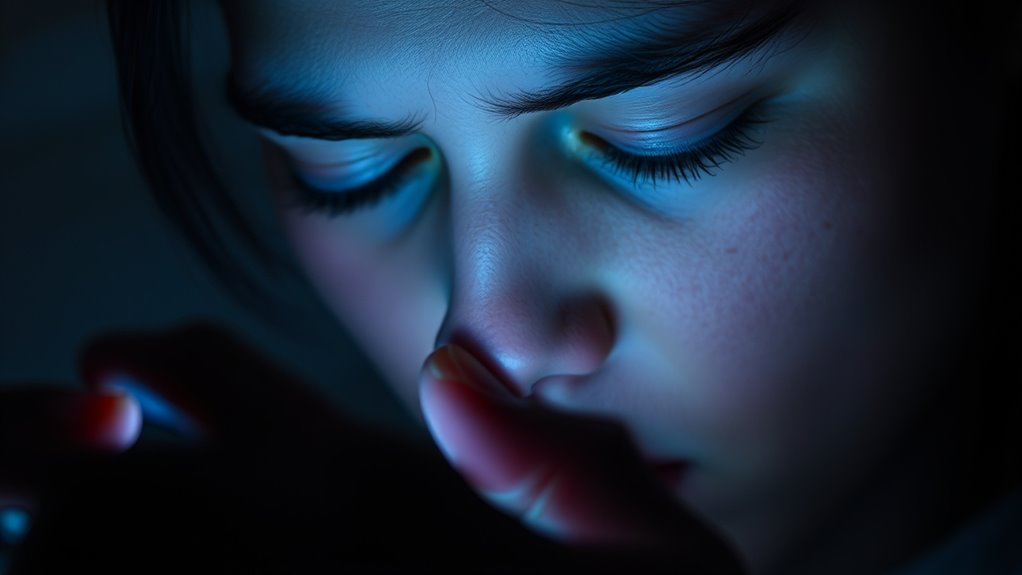
Blue light directly affects your body’s production of melatonin, the hormone that helps you sleep. The timing of your exposure matters—using screens late at night can markedly suppress melatonin levels. This disruption throws off your circadian rhythm, making it harder to fall asleep and wake up refreshed.
Blue Light’s Melatonin Impact
Research shows that exposure to blue light after sunset can considerably disrupt your body’s natural production of melatonin, the hormone responsible for regulating sleep. This melatonin suppression delays sleep onset and reduces sleep quality, leading to overall sleep disruption. Blue light interferes directly with the cells in your retina that signal melatonin release, hindering its normal rise at night. To understand this better, consider the following:
| Light Type | Effect on Melatonin |
|---|---|
| Blue Light | Significant melatonin suppression |
| Red/Amber Light | Minimal impact on melatonin |
| Bright White | Moderate melatonin suppression |
Limiting blue light exposure in the evening helps preserve melatonin production and supports healthier sleep patterns. Additionally, using blue light filters on devices or wearing specialized glasses can further mitigate blue light’s impact on melatonin levels.
Timing of Exposure Matters
Even if you limit blue light exposure during the day, the timing of when you encounter it still matters. Light exposure late at night has a stronger effect on melatonin suppression than light exposure earlier in the evening. Your sleep timing influences how your body responds to blue light, with late-night exposure disrupting your natural melatonin surge. This means that even brief exposure to blue light close to bedtime can notably delay sleep onset. It’s not just about total exposure but when you’re exposed that impacts your sleep quality. To protect your melatonin production, try to minimize blue light exposure during the hours leading up to bedtime. Adjusting your light exposure timing helps maintain your circadian rhythm and supports better sleep. Incorporating sound vibrations into your evening routine may also promote relaxation and better sleep quality.
Circadian Rhythm Disruption
Since your circadian rhythm governs your sleep-wake cycle, disruptions to this internal clock can have significant effects on your overall health. Light pollution from artificial sources, especially blue light exposure at night, can cause circadian misalignment, throwing off your body’s natural timing. When your internal clock is disrupted, melatonin production drops, making it harder to fall asleep and stay asleep. This misalignment can lead to sleep deprivation, decreased alertness, and long-term health risks like metabolic issues and weakened immunity. The more exposed you are to artificial blue light during evening hours, the greater the risk of disturbing your circadian rhythm. Additionally, ongoing AI security research highlights the importance of safeguarding health data and personal information related to sleep health. Protecting your sleep involves minimizing light pollution and avoiding blue light screens before bed to keep your internal clock running smoothly.
Surprising Ways Blue Light Affects Your Brain Function
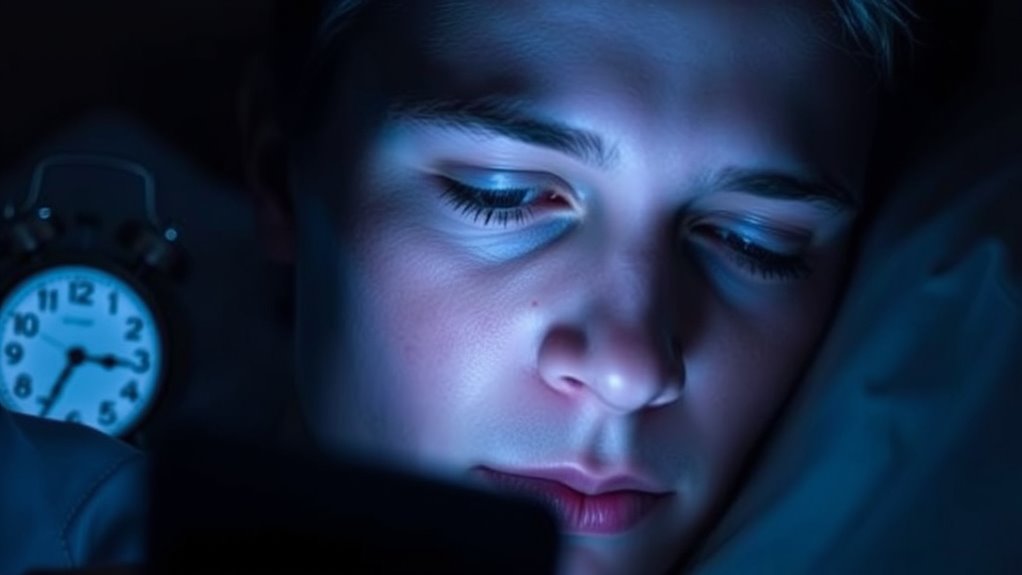
Blue light doesn’t just influence your sleep; it also has surprising effects on your brain’s function. Exposure can enhance or impair brain plasticity, depending on the timing and duration. When you’re exposed to blue light during the day, it can boost alertness and support cognitive enhancement, helping you stay focused and sharp. However, excessive exposure, especially in the evening, may hinder your brain’s ability to adapt and learn. Here’s a quick look:
| Effect | Benefit | Risk |
|---|---|---|
| Brain plasticity | Improves learning capacity | Disrupts adaptation |
| Cognitive enhancement | Sharpens focus and memory | Overstimulation |
| Mood regulation | Boosts motivation | Anxiety or agitation |
| Alertness | Keeps you awake | Sleep disturbances |
| Creativity | Sparks new ideas | Fatigue reducing insight |
Understanding these effects helps you harness blue light’s power wisely. Being aware of proper light exposure timing can maximize benefits while minimizing risks.
The Impact of Evening Screen Time on Sleep Quality
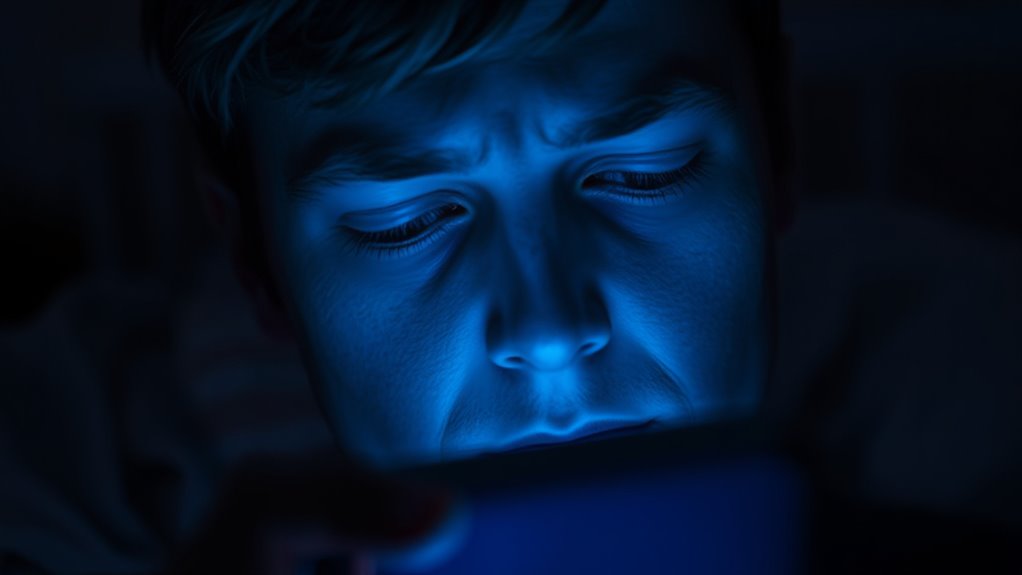
When you spend time on screens in the evening, blue light can reduce your melatonin production, making it harder to fall asleep. This suppression delays your sleep onset, leaving you restless longer than you’d like. Understanding these effects can help you make better choices for a more restful night. Additionally, adaptive learning technologies in health education emphasize the importance of managing screen time to improve sleep quality.
Melatonin Suppression Effects
Evening screen time can considerably disrupt your body’s natural sleep processes by suppressing melatonin production. Melatonin levels, which signal your body that it’s time to wind down, decline when exposed to blue light from screens. This suppression hampers your ability to fall asleep and hampers sleep quality overall. The reduction in melatonin can also lead to circadian disruption, throwing off your internal clock and making it harder to maintain regular sleep patterns. As a result, you might find yourself awake longer or experiencing lighter, less restorative sleep. Continuous exposure to blue light in the evening fundamentally tricks your brain into thinking it’s daytime, delaying the natural rise of melatonin and interfering with your sleep cycle. This disturbance ultimately impacts your overall sleep health and daily functioning. Additionally, the type of headphones you use during screen time can influence your exposure to blue light, especially if they have built-in screens or are used with devices emitting blue light.
Delayed Sleep Onset
Because screens emit blue light that suppresses melatonin, your ability to fall asleep promptly is often delayed after evening use. The blue light interferes with your body’s natural sleep signals, causing a sleep delay. Instead of feeling sleepy when you intend to, you may find yourself lying in bed longer, staring at your device. This disruption can lead to inconsistent sleep schedules and reduced sleep quality. The longer your exposure to blue light before bed, the more your circadian rhythm is thrown off, making it harder to shift into restful sleep. Recognizing the connection between blue light and sleep delay helps you take steps toward better sleep hygiene. Additionally, research shows that circadian rhythm disruption can have long-term health impacts if not managed properly.
Blue Light’s Role in Increasing Sleep Onset Latency

Blue light exposure before bedtime can considerably delay your ability to fall asleep by increasing sleep onset latency. This effect occurs because blue light suppresses melatonin, the hormone that signals your body it’s time to sleep. When melatonin production drops, your internal clock shifts, making it harder to shift into sleep. To understand this better, consider:
- Blue light impacts your circadian rhythm, pushing sleep onset later.
- Reduced melatonin levels extend the time it takes to feel sleepy.
- Increased sleep latency means your body stays awake longer, disrupting your sleep cycle.
- Tuning your environment with performance kits can help mitigate the effects of blue light exposure on sleep patterns.
Long-Term Health Risks of Blue Light Exposure
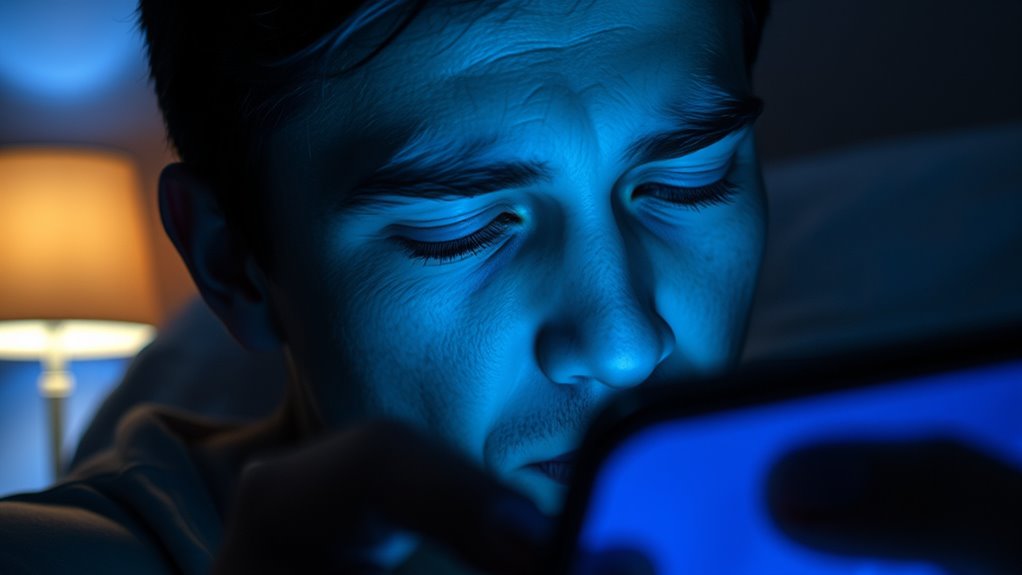
Prolonged exposure to blue light can pose serious long-term health risks, extending beyond sleep disruption. Over time, blue light may contribute to deteriorating eye health, increasing the risk of conditions like digital eye strain and retinal damage. Continuous exposure can cause discomfort, blurred vision, and even potential damage to your retina, affecting your eyesight permanently. Additionally, blue light exposure accelerates skin aging by damaging collagen and elastin fibers, leading to wrinkles and loss of skin elasticity. This exposure can cause oxidative stress, promoting inflammation and skin dullness. While short-term effects are well-known, the cumulative impact on your eye health and skin underscores the importance of taking protective measures. Being aware of these risks helps you prioritize long-term well-being in a digital age.
Simple Strategies to Minimize Blue Light Damage
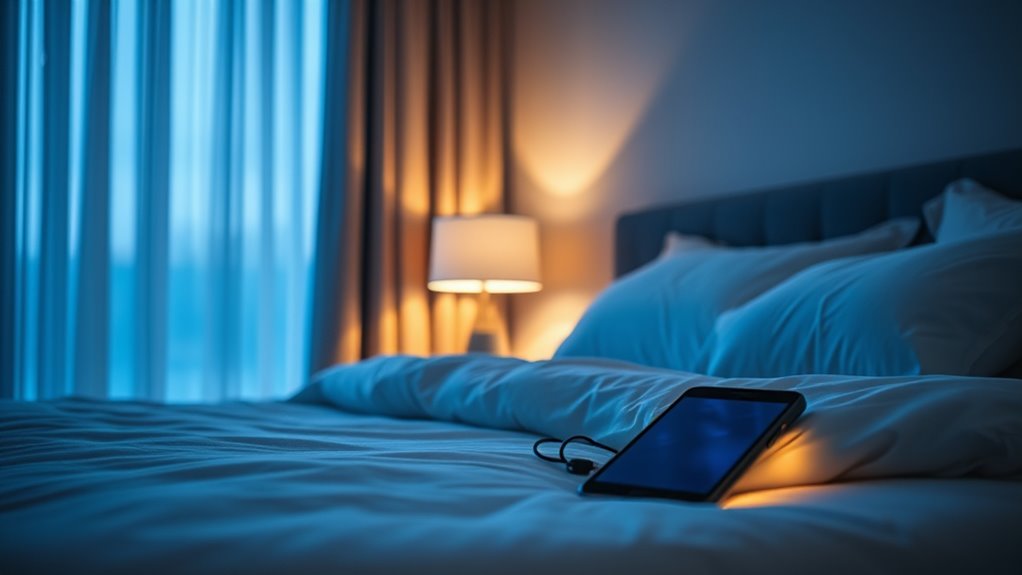
To protect your eyes and skin from the long-term damage caused by blue light, adopting simple, practical strategies can make a significant difference. First, use screen filters on your devices to reduce blue light exposure without sacrificing functionality. Second, invest in blue light glasses; they block or filter blue wavelengths, especially during evening hours. Third, set boundaries by limiting screen time before bed, giving your body a chance to wind down naturally. These steps help minimize blue light’s impact on your circadian rhythm and overall health. Incorporate these habits consistently, and you’ll better safeguard your sleep quality and long-term eye health. Small changes can lead to meaningful protection against blue light damage. Additionally, understanding how blue light affects sleep patterns can motivate you to stick with these protective habits.
The Best Devices and Apps to Protect Your Sleep
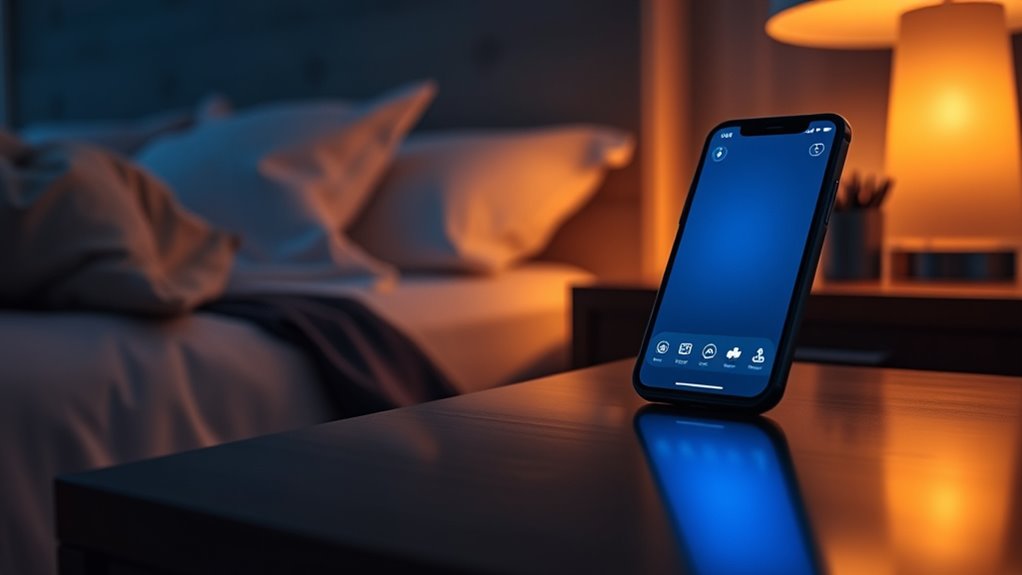
Choosing the right devices and apps can make a significant difference in safeguarding your sleep from blue light interference. Many tools are designed to reduce blue light pollution and ease digital eye strain, helping you wind down more naturally. Blue light filters and screen dimming apps, like f.lux or Night Shift, automatically adjust your screen’s color temperature as evening approaches, limiting blue light exposure. Additionally, blue light-blocking glasses are effective when you need to use devices before bed. Some apps even schedule screens to shift to warmer tones, reducing eye strain and improving sleep quality. By investing in these devices and apps, you actively protect your circadian rhythm, minimize sleep disruptions, and create a healthier digital environment for restful nights.
Debunking Common Myths About Blue Light and Sleep
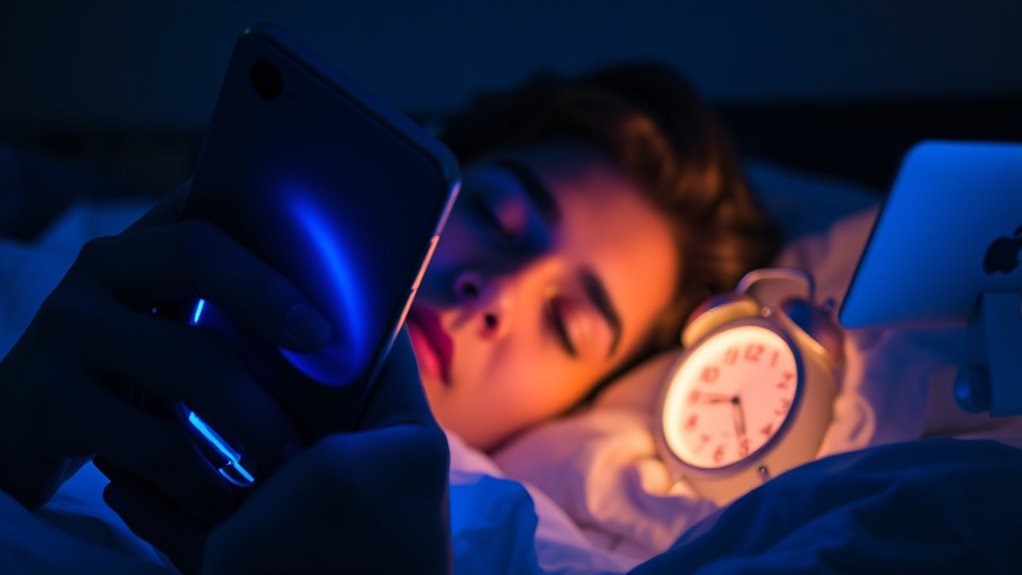
Many people believe that blue light exposure before bed is solely responsible for disrupting sleep, but this isn’t entirely accurate. This is a common sleep misconception fueled by blue light myths. In reality, other factors like stress, caffeine, and overall sleep hygiene play vital roles. To clarify:
- Blue light isn’t the only factor affecting melatonin production.
- Not all blue light exposure impacts sleep equally—timing and duration matter.
- Reducing screen time isn’t a silver bullet; lifestyle choices matter too.
Understanding these sleep misconceptions helps you avoid unnecessary worries. While limiting blue light exposure can improve sleep, it isn’t the sole solution. Recognize that a holistic approach is essential for better rest, beyond just blue light myths.
Frequently Asked Questions
Can Blue Light Exposure Affect Children’s Sleep Patterns Differently?
Yes, blue light exposure can affect children’s sleep patterns differently. When you limit screen time before bedtime, you help establish better routines that promote melatonin production. Blue light from screens can interfere more with children’s developing sleep cycles, making it harder for them to fall asleep. So, reducing screen time and creating consistent bedtime routines can markedly improve their sleep quality and overall health.
Does Blue Light Exposure Impact Sleep Quality During Daytime Naps?
Yes, blue light exposure during daytime naps can impact your sleep quality by causing melatonin suppression and circadian disruption. When you’re exposed to blue light, it signals your brain that it’s daytime, making it harder to fall asleep or achieve deep rest during your nap. To improve your nap quality, limit blue light exposure beforehand, and consider using blue light filters or glasses if you’re in front of screens.
Are There Specific Types of Blue Light That Are More Harmful Than Others?
Ever wonder if some blue light is more dangerous than others? Shorter wavelengths, like those around 415-455 nm, have higher spectral sensitivity and pose greater wavelength hazards, making them more harmful. Blue light from screens, especially in this range, can disrupt your melatonin production and sleep patterns. So, yes, specific types of blue light, particularly high-energy blue-violet, are more damaging than others and deserve your attention.
How Does Blue Light Influence Dreams and REM Sleep Phases?
Blue light exposure before bed can suppress REM sleep, making your dreams less vivid and harder to recall. When REM is reduced, you might notice fewer dreams or difficulty remembering them, affecting dream recall. This suppression occurs because blue light interferes with melatonin production, delaying REM phases. To improve your dreams and sleep quality, limit blue light exposure in the evening, especially from screens, and create a relaxing pre-sleep routine.
Can Blue Light Exposure Lead to Long-Term Cognitive Decline?
Could blue light exposure cause long-term cognitive decline? It’s possible, as excessive exposure can lead to neural damage and memory impairment over time. When you stay on devices late into the night, blue light disrupts your natural sleep cycle, which is vital for brain health. Consistent disruption may accumulate, increasing your risk of cognitive issues later. To protect your brain, limit screen time before bed and consider blue light filters.
Conclusion
Understanding blue light’s impact on your sleep is like revealing a hidden door; once you see it, you can’t ignore the secrets it holds. By taking simple steps, you can protect your nights and restore your natural rhythm. Don’t let screens be the thief of your restful sleep—your health depends on it. Embrace these strategies, and let your nights regain their peaceful, restorative power. After all, isn’t your well-being worth the effort?
